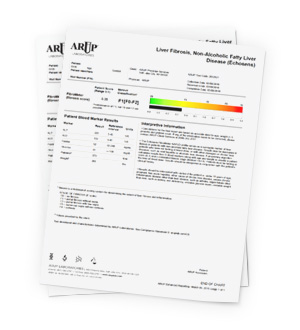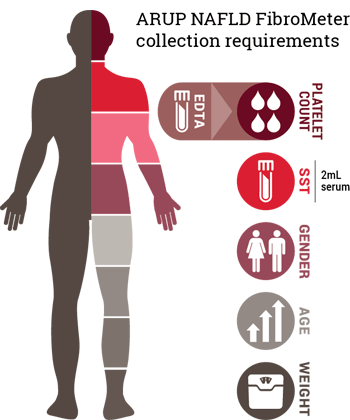
Non-alcoholic liver disease (NAFLD) is considered the hepatic manifestation of metabolic syndrome and is the primary cause of chronic liver disease in industrialized nations. NAFLD represents a wide spectrum of liver pathology and ranges from benign, fatty liver or steatosis to non-alcoholic steatohepatitis (NASH), which is the cause of liver fibrosis. Progressive liver fibrosis is associated with increased risk of cirrhosis and hepatocellular carcinoma (HCC).
The gold standard for establishing a NAFLD diagnosis is a liver biopsy, which is also used to monitor the progression of liver fibrosis. However, liver biopsy is an invasive and costly procedure subject to sampling errors and inaccuracy due to inter- and intra-observations of pathologic interpretations.
The FibroMeter NAFLD test is a non-invasive alternative to liver biopsy and serves as a surrogate marker of liver fibrosis specifically in patients with chronic liver disease due to NAFLD. A proprietary algorithm calculates results based on patient clinical data (age and weight) and five blood biomarkers: platelet count, AST, ALT, ferritin, and glucose.
A patient score (0–1) and correlated fibrosis Metavir stage (F0–F4) are provided. Fibrosis stage has been shown to be the strongest predictor of mortality associated with NAFLD.
Education Resource
- Non-invasive Assessment of Liver Fibrosis
by Patricia R. Slev, PhD

View sample enhanced graphical report
Test Details
Scores are algorithmically calculated from values of blood biomarkers, platelet count, demographic information.
| Measurements Performed by ARUP | ALT, AST, ferritin, glucose |
|---|---|
| Information Provided by Client | Patient's platelet count, age, gender, weight |
| Calculated Scores | Score ranges from 0 to 1, 1 being the most severe stage:
|
| Metavir Classifications | Corresponding classifications are reported together with the scores:
|
Method Comparison
| FibroMeter | Liver Biopsy | |
|---|---|---|
| Nature of Test | Non-invasive | Invasive |
| Advantages | Measurement of global fibrosis, suitable for serial observations | Direct, evaluation of co-exisiting pathologies |
| Limitations | Indirect measurement of functional changes of the liver | Sampling error, inter-observer variability, possible hospitalization |
| Risks | Very little risk | Pain, bleeding, pneumothorax, hemothorax, infection |
| Cost | Less expensive than biopsy | Expensive |
| Contradictions | None known | Uncooperative patient, severe coagulopathy, extrahepatic biliary obstruction, ascites, morbid obesity |
Ordering Information
How to Order
Please contact your hospital or reference laboratory to inquire about pricing, test-request forms, and billing for this test.
Test Information
| Test Name | Liver Fibrosis, Non-Alcoholic Fatty Liver Disease (Echosens FibroMeter) |
|---|---|
| Test Code | 2012521 |
| Mnemonic | FIBRO NAFLD |
| Method | Quantitative Enzymatic/Quantitative Spectrophotometry/Automated Cell Count/Quantitative Chemiluminescent Immunoassay |
| Specimen Information | 2 mL serum. Must supply patient platelet count performed on EDTA whole blood (ordered separately through client institution) |

Specimen Collection Requirements
| Collection | Lavender (EDTA) or Pink (K2EDTA) for platelet count AND Serum Separator Tube (SST). |
|---|---|
| Preparation | Separate from cells ASAP or within 2 hours of collection. Transfer 2 mL serum to an ARUP Standard Transport Tube. (Min: 1.2 mL) |
| Transport Temperature | Serum should be shipped frozen; do not send the EDTA whole blood to ARUP. |
| Remarks | This test requires an automated platelet count performed on the EDTA whole blood sample at the client site. Include the platelet count with the patient test submission information. This test requires the patient’s weight (in pounds). Include the patient’s weight with the sample submission. |
| Specimen Stability | From time of collection to initiation of testing: Serum: Ambient: 8 hours; Refrigerated: 48 hours; Frozen: 2 weeks |
















